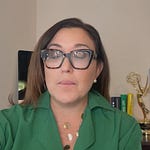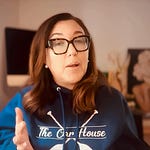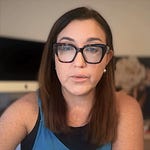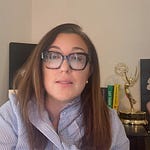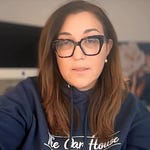by Teri Arvesú González
When I was in Catholic school, there was a simple song we used to sing in kindergarten:
“This little light of mine, I’m gonna let it shine.”
At the time, it felt like just a children’s song. But as I’ve grown, I’ve come to believe it carried a deeper truth. That “light” wasn’t something I had to invent. It was something God had already given me.
That light shows up in the form of strengths—natural gifts, the things that come alive in us without forcing. And our responsibility isn’t just to notice them, but to develop them—turning raw strengths into skills, and then aligning those skills with the work we do in the world.
How to Identify and Develop Your Strengths
Identifying strengths isn’t always straightforward. Sometimes we need help—someone to reflect back what we can’t yet see in ourselves. That can look like:
a parent or teacher who notices what lights you up
a mentor who sees a through-line in your wins
an assessment that gives language to your gifts
I was lucky. My mom saw my love of storytelling, reading, and helping others—and she guided me toward a path where those strengths mattered.
And years later, a mentor entered my life who would make a profound impact. She not only asked me a question I’ll never forget (more on that later), but she also introduced me to an assessment at 41 years old that finally clicked. That assessment gave me permission to stop obsessing over “fixing” weaknesses and instead double-down on refining my strengths—while finding partners and processes to cover what wasn’t mine to carry.
Once identified, strengths don’t grow themselves. They require intentional choices:
picking activities in school that stretch your gifts
choosing college courses and certificates that deepen them
pursuing roles and projects that convert strengths into repeatable, reliable skills
When I was a manager, I’d tell people who were frustrated by a colleague’s under-performance: “Nobody wakes up in the morning wanting to screw things up.” More often than not, the person was miscast or misaligned—not lazy. Alignment is not an accident; it’s the intentional shaping of what God gave us into tools that serve.
That’s the work: discovery, development, and discernment.
The Obstacles to Alignment (Internal and External)
When we do that—when we let the light shine unobstructed—we step into God’s intended purpose for us.
Saint Ignatius of Loyola said:
“No one knows what God would do with us if they did not oppose so many obstacles to His grace.”
And that’s the challenge, isn’t it? The obstacles.
Obstacles—or derailers—show up both inside and outside of us.
Internal Obstacles
Self-doubt whispers that we’re not ready or not worthy.
Conditioning tells us to play small, follow the rules, stay quiet.
Trauma—whether personal, cultural, or generational—leaves us carrying weight that isn’t ours.
Inherited fear is the kind our well-intended families pass down to keep us safe from failure or rejection. It’s loving, but it can become a dimmer switch on our light.
External Obstacles
Systemic barriers like bias, discrimination, and inequitable opportunities.
Institutional expectations that reward conformity instead of authenticity.
Cultural scripts that dictate who belongs where, and who doesn’t.
Limited access and opportunity that close doors before we even get to knock.
And for children of immigrants, these challenges are often amplified. We inherit unspoken rules: Don’t fail in public. Don’t stand out too much. Don’t waste the sacrifice that got you here.
These scripts come wrapped in love… but they can dim the very light we were called to shine.
If you follow my writing at The TAG Collab, you know I often linger here—on these cultural scripts, on the intergenerational weight of immigration. On how we can both honor our families’ sacrifices and unlearn what keeps us small.
Why We Focus Too Much on Fixing Weaknesses
Have you ever noticed how much time we spend trying to “fix” what’s wrong with us? From school report cards that circled the C instead of celebrating the A, to performance reviews that spotlight “areas of improvement,” the message is clear: focus on what’s broken.
But what if that lens has been holding us back?
As humans, we’re wired with a negativity bias—a survival mechanism that kept our ancestors safe by paying more attention to threats than to opportunities. The problem is, that wiring leaks into our self-perception. We zoom in on shortcomings, flaws, and insecurities because our brain treats them like threats.
Society reinforces it, too. Parents, teachers, bosses—often unintentionally—spend more time correcting weakness than amplifying what’s already working. Even our self-talk falls into this trap: If only I could get better at… instead of I’m great at… how do I use that more?
No wonder when I tell people, “You’ll go further refining your strengths than fixing your weaknesses,” their eyes light up. It’s like permission they’ve been waiting for.
Stop Fixing Your Flaws—Start Soaring with Your Strengths
One of the most impactful lessons I’ve learned about work, life, and even parenting is that we spend far more time trying to fix our defects than refining and excelling at our strengths.
Years ago, a mentor of mine asked me a question I’ll never forget. (She was the same mentor who later introduced me to the assessment that changed how I operate—helping me see my strengths more clearly and giving me permission to lean into them.)
She asked:
“When you were a kid, if you brought home a report card with all A’s and one C…what was the topic of conversation at dinner that night?”
For so many of us, the answer is obvious: the conversation focused on the C.
Even with a report card full of excellence, we zoom in on the one shortfall. It’s how many of us were raised, how many of us were managed at work, and how many of us instinctively parent our own kids. We’re trained to spot gaps, weaknesses, and flaws—and pour our energy into fixing them.
But what if that’s backward?
I remember reading Soar with Your Strengths by Donald O. Clifton and Paula Nelson, which makes the bold claim that “You can’t be anything you want to be—but you can be a lot more of who you already are.”
Instead of trying to be well-rounded individuals, we should double down on our unique talents and natural strengths.
It reminded me of the fable in the book about the animals in the forest who started a school. All animals had to take all classes: running, climbing, swimming, and flying. The duck, who was a phenomenal swimmer, nearly lost his talent because he spent all his time trying to fly. The eagle, born to soar, was forced to run instead. In the end, everyone became mediocre—and no one excelled.
The truth is, teams should be well-rounded, not individuals.
Of course, that doesn’t mean ignoring weaknesses entirely. Where we have deficiencies, we look for the right partners to offset them. That’s the art of building great teams: recognizing what you do brilliantly and where you need support.
If you’re building a house, you can’t hire only bricklayers. You also need electricians, plumbers, roofers, designers—people with different skill sets who together can create something none of them could build alone.
It’s the same in business, in community work, and in families. When building a team, it’s important to recognize the balance—or to spot where the team may be lacking a fundamental skill set.
I’ve applied this thinking both at work and at home. As a parent, I remind myself that my children don’t need to be equally great at everything; they need to discover and nurture what lights them up. As a leader, I try to build teams where people get to shine in their strengths—and where we collectively support one another in areas where we’re less strong.
It’s natural to want to improve weaknesses, especially when they cause real obstacles. But if we spend all our energy fixing C’s, we risk neglecting the A’s—the places where we could become exceptional.
So the next time you’re tempted to obsess over your “C,” ask yourself:
What would happen if I invested that time into my A’s instead?
How could I take what I’m naturally good at and make it world-class?
And how can I build partnerships and teams that complement the places where I’m less strong?
Because in the end, nobody remembers the middle-of-the-road ducks who tried to fly. We remember the ducks who swim like nobody else—and the teams who build the whole house, not just the brick wall.
The Case for Refining Strengths Instead of Fixing Weaknesses
Here’s the truth:
Weakness-fixing leads to average. You might get to “good enough,” but rarely to exceptional.
Strength-refining leads to advantage. When you double down on what comes naturally, you compound your energy, joy, and skill. That’s where competitive advantage is born.
Energy follows strengths. Working on weaknesses drains us. Refining strengths energizes us. That energy is what sustains growth over the long haul.
How to Reframe Your Approach to Growth
Think of your strengths as instruments. You could spend your whole life trying to play the ones you’re not built for—or you could become world-class at the ones already in your hands.
The shift is simple but radical:
Don’t ask, “How do I get better at what I’m bad at?”
Ask, “How do I use more of what I’m great at?”
Instead of pouring effort into patching weaknesses, design your career, your leadership, and even your daily routines to showcase and stretch your strengths. Delegate, automate, or collaborate around the rest.
Permission to Be Brilliant at What You Already Do Best
So here’s your permission slip: you don’t need to be good at everything. You don’t need to perfect every flaw. You just need to master being you.
When you refine your strengths, you create impact with less friction. You stop fighting uphill battles. You feel in flow. And you unlock what so many miss: your unique competitive edge.
That’s the secret people feel when they say, “Oh my God, that’s so true.”
A Note for Parents
While this article is written for the individual, it is also meant for parents. Our children don’t need to be equally great at everything; they need the freedom to discover what lights them up. Just as leaders build well-rounded teams, parents raise well-rounded families by nurturing each child’s unique strengths and surrounding them with support in the areas where they’re less strong.
The lesson is the same: stop pouring all your energy into fixing the “C’s” and start investing in the “A’s.” Give your children permission to lean into their gifts, so they can align their lives with their light.
After taking those assessments myself, I even created a ChatGPT tool for my kids—one that helps them identify their strengths and see how to apply them in real life. I use it in my parenting, and I’ve built a version for myself too. It’s been a game-changer in how we talk about gifts, growth, and alignment as a family.
👉 If you’d like to learn more about that, please DM me.
Questions to Guide Your Next Step
Reflect today:
Which “weakness” am I wasting too much time trying to fix?
Which strength, if I refined and showcased it, could change the game for me right now?
As a parent, how can I model this shift—so my children grow up seeing their strengths as their greatest asset?
Because the truth is, no one ever won by being flawless. They won by being brilliant at their strengths.
✨ Final Reflection Question for You:
Where are you letting obstacles—or inherited fears—dim your light? And what would alignment look like if you allowed God’s purpose to flow through you, unobstructed?
About the Author
Teri Arvesu Gonzalez is the founder of The TAG Collab, a consultancy that helps mission-driven companies align purpose, brand, and strategy from the inside out.
With a Master’s in Management and Leadership and more than 25 years of experience leading newsrooms, launching initiatives, and driving transformation across Miami, Chicago, and national corporate teams, she brings deep expertise in storytelling, culture-building, and operational alignment.
Also find me on:
Podcast: on Apple Podcasts and Spotify The TAG Collab
Instagram: https://www.instagram.com/the_tag_collab/
Facebook: https://www.facebook.com/profile.php?id=61576206521962
Linkedin: https://www.linkedin.com/in/teriarvesu/



